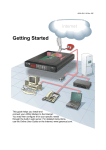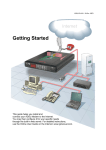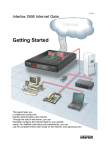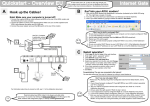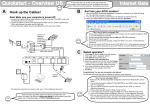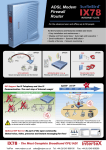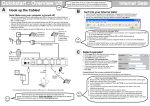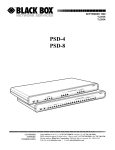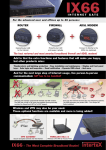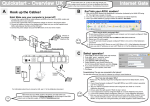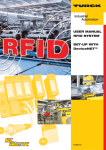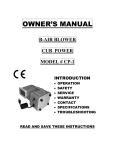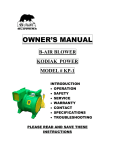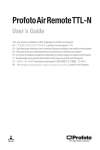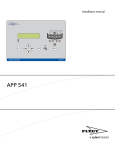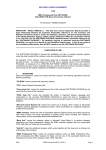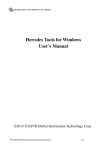Download English - Intertex Data AB
Transcript
Qsadd66-EN-3.12-Rev. 05B Addendum to the Quickstart - Overview Sheet To install your Internet Gate, follow the A, B and C steps of the Quickstart sheet! If you run into problems or need further information, this Addendum will help with the most common issues. After the installation, you can configure the Internet Gate for your specific needs through the built-in web interface. For detailed instructions, use the Online User Guide on the Internet: www.igmanual.com. Contents 1 Basic Set Up .....................................................................................................................................3 2 Getting Help ......................................................................................................................................3 3 Detailed Instructions .........................................................................................................................4 3.1 Connecting a Local Network (LAN)...........................................................................................4 3.2 Check Your PC’s Settings.........................................................................................................4 3.2.1 Using the Internet Gate with Dynamic IP Addresses on the LAN ..................................5 3.2.2 Using the Internet Gate with Static IP Addresses on the LAN .......................................6 3.3 Check the Proxy Settings of Your Web Browser ......................................................................7 3.4 Diagnostic Test .........................................................................................................................8 3.5 Reset to Factory Defaults..........................................................................................................8 4 Configure Your Internet Gate............................................................................................................9 4.1 Network Settings .......................................................................................................................9 4.2 Security Profiles ..................................................................................................................... 10 5 Requirements................................................................................................................................. 11 END USER SOFTWARE LICENSE AGREEMENT .............................................................................. 12 2 1 Basic Set Up Please refer to step A, B and C of the Quickstart sheet for the basic set up of your Internet Gate. It will guide you in installing the Internet Gate and in doing the necessary settings. 2 Getting Help HELP! There are several ways to get information about the Internet Gate: • Quickstart Overview Sheet – Helps you install and do some basic configurations. • Addendum to the Quickstart – Overview Sheet (this document) – Helps you to troubleshoot the most common issues. • Built-in Help – Every configuration page on the built-in web server has help texts that describe the different parameters. Just click the question marks. • Online User Manual – In the online manual, you will find the latest information tailored for your specific version of the Internet Gate. You access it via links in the Built-in Help, via the link on the first web page of the Internet Gate or directly at www.igmanual.com. • Support – If you experience problems when installing or using the Internet Gate that cannot be solved by the help indicated above, contact your retailer for assistance. • Using SIP: Telephony, Video, Messaging... – This online information, accessible from the first page of the web interface, helps you get your IP Telephony and SIP environment up and running. Upgrade? Click to check whether a newer firmware is available! Surf to your Internet Gate by typing its default IP Address: 192.168.0.1 to configure it or to get further help! 3 3 Detailed Instructions Do you have problems getting your Internet Gate to work? Read the installation tips and the detailed instructions on the following pages for help! 3.1 Connecting a Local Network (LAN) If you have a Local Area Network (LAN) with several computers connected, you can connect the network hub to your Internet Gate and allow all computers to share the Internet connection. If your network uses dynamic IP-addressing (recommended), then the built-in DHCP server of your Internet Gate will provide IP addresses to all PC:s on the LAN. Refer to 3.2.1 for more information. Does your network use static IP addresses? Refer to 3.2.2! Note: • Only one computer can be connected to the USB port on the Internet Gate. No LAN can be connected to the USB port. Instead, use the Ethernet port and a hub to connect the LAN. • Some simpler models of the Internet Gate are locked so they are only able to connect a single computer through the LAN interface. This lock is then indicated on the bottom of the web page Network (refer to 4.1). To connect a LAN to such models, the firmware must be upgraded to a version with LAN functionality. 3.2 Check Your Computer’s Settings The Internet Gate is delivered with factory defaults that fit most users. If your PC has the default network and web settings, then everything should work at once. If not, please check your PC’s settings. (The steps described here are for Windows XP. Other operating systems have similar menus and options, though accessing them may be done differently.) • Select Network Connections in Windows Control Panel. (Click Start and choose Control Panel). Right click on the network connection that you use and select Properties. I have no “Network Connections” icon on my desktop! Why? You need a network card installed in your computer. Configure it according to the instructions from the manufacturer. • Double click on Internet Protocol (TCP/IP) for your network card on the list that appears. There is no ”Internet Protocol (TCP/IP)” in the list! Why? It is not installed. Select ”Install”, ”Protocol”, “Add”, ”Microsoft TCP/IP”, “OK”. There are two ways to address computers in a local network (LAN): a) Either Dynamic IP addressing, a DHCP server on the LAN distributes IP addresses to all connected computers, b) or Static IP addressing, all connected computers use a manually assigned IP address. 4 Check how your computer is configured to receive an IP address: a) If it is configured to use dynamic addressing, the settings look like this: b) If it uses static IP addresses the setting look something like this: No configuration is needed. The DHCP server built into your Internet Gate will distribute correct IP addresses. Check your setting according to 3.2.1, 3.3, and 4.1. 3.2.1 You have two options: 1 (recommended): Configure all computers on your LAN to use dynamic IP addressing. Refer to 3.2.1 for more information. 2: Configure your Internet Gate and your PC:s so they fit your LAN. Refer to 3.2.2 for more information. Using the Internet Gate with Dynamic IP Addresses on the LAN The Internet Gate is delivered configured for dynamic IP addressing on the LAN. The Internet Gate acts as a DHCP server and provides IP addresses. (The steps described here are for Windows XP. Other operating systems have similar menues and options, though accessing them may be done differently.) All PCs on your LAN should be configured like this: 1. Select Network Connections in Windows Control Panel. Right click on the network connection that you use and select Properties. 2. Double click on Internet Protocol (TCP/IP) for your network card on the list that appears. 3. Select Obtain an IP address automatically and Obtain DNS server address automatically. 4. Click OK to save and close all windows and reboot the PC. 5. You may check that the built-in DHCP server of your Internet Gate is enabled, by checking the settings of the LAN port (ET1 or ET2 dependent on model) in the Network Settings web page. 5 You can see the most common settings here to the right. These should suit most users. If you already run a DHCP server on your LAN you should turn it off or change its settings to distribute the Internet Gate as default gateway. 3.2.2 Using the Internet Gate with Static IP Addresses on the LAN Note: This information is intended for advanced users. If you are not familiar with terms like static IP addressing you do not need to read this chapter. Refer to 3.2.1 instead. If you want your Internet Gate to be part of an existing LAN that uses static IP addresses, you have to change its LAN IP address to an unused IP address that fits the same subnet as your LAN. You can use the keys on the front panel to change the IP address: 1. Press and hold SET pressed for 3 seconds, to enter setup mode. AD 2. Press SELECT once, so CFG is lit. AD 3. Press SELECT repeatedly until ”E 2” (ET2) appears in the display for models with built-in ADSL. For firewall models without ADSL, the LAN port is instead ET1 and “E 1” should appear. AD CFG DHP RST CFG DHP RST LQ TX RX CFG DHP RST LQ TX RX LQ TX RX 4. Press SET . 5. Press SET . The first 3 digits of the IP address are shown and the first digit flashes. AD CFG DHP RST LQ TX RX 6. Press ALT CFG repeatedly, until the correct digit is displayed. 7. Press SELECT : The next digit flashes, and can be changed using ALT CFG . AD CFG DHP RST LQ TX RX 8. Use SELECT to step through all digits of the IP address. Use SET to step back to the previous digit if you have made any error. Use ALT CFG to change the value of the flashing digit. You can cancel the IP address set-up, without saving any changes, by pressing the SELECT key and holding it pressed for 2 seconds. 9. After stepping through all digits of the IP address, the subnet mask appears and can be modified. Each subnet mask number can only be set to values 255, 254, 252, 248, 240, 224, 192, 128, or 0. AD CFG DHP RST LQ TX RX 10. Press ALT CFG repeatedly, until the correct value is displayed. Press SELECT to step to the next subnet mask number. 11. When all digits have been displayed the IP address and subnet mask are saved. AD CFG DHP RST LQ TX RX 12. Complete the installation with the steps on the next page. 6 Is your Internet Gate not equipped with display and keys? Do like this: • Connect a PC to the LAN port (ET2 for ADSL models, ET1 for firewall models) on your Internet Gate and configure the PC to use dynamic IP addressing. Refer to 3.2.1. • Change the setting for the LAN port on your Internet Gate through the builtin web interface. Refer to 3.1. • Change PC IP configuration back to its static settings. • Complete the installation with the steps on this page. (The steps described here are for Windows XP. Other operating systems have similar menus and options, though accessing them may be done differently.) The procedure below has to be performed for all computers connected to your local network (LAN). 1. Select Network Connections in Windows Control Panel. Right click on the network connection that you use and select Properties. 2. Double click on Internet Protocol (TCP/IP) for your network card on the list that appears. 3. Select Use the following IP address. 4. Enter the IP address and Subnet mask of the computer. As Default gateway enter the IP address of your Internet Gate. Either the default 192.168.0.1 or the one you entered in the previous section. 5. Enter the IP address of the Preferred and Alternate DNS server. 6. Click OK. 3.3 Check the Proxy Settings of Your Web Browser If your web browser is configured to use a proxy server, you may have problems reaching the built-in pages of your Internet Gate. In that case, disable the proxy server in your browser: Netscape Navigator: Internet Explorer: Select Edit, Preferences, Advanced, Proxies: ”Direct connection to the Internet” should be selected. Select Tools, Internet Options, Connections, LAN settings. The checkbox ”Use a proxy-server for your LAN” must not be selected. 7 3.4 Diagnostic Test If you cannot access the Internet, your Internet Gate can attempt to localise the problem. Note: The diagnostic test is only available in models with keys and display. Start the diagnostic test like this: 1. Press and keep SET pressed 3 seconds to enter setup-mode. AD 2. Press SELECT 4 times until “LQ” is lit. AD CFG DHP RST LQ TX RX CFG DHP RST LQ TX RX 3. Press SET . It takes a couple of seconds to perform the test. Any errors discovered are shown in the display. The diagnostic test can find multiple errors, press SELECT to flip through all error messages. ”E 1” to ”E 9” indicate errors in your external Internet connection (WAN): AD CFG DHP RST LQ TX RX AD CFG DHP RST LQ TX RX AD CFG DHP RST LQ TX RX AD CFG DHP RST LQ TX RX AD CFG DHP RST LQ TX RX No WAN link connection (ADSL or Ethernet dependent on model). Check all cables. Contact your broadband-supplier if the error remains. No WAN DHCP server found. This may be OK, but check configuration according to 4.1. Reboot your Internet Gate. Contact your Internet Service Provider (ISP) if the error remains. No Gateway found. This may be OK, but check configuration according to 4.1. Reboot your Internet Gate. Contact your Internet Service Provider (ISP) if the error remains. No DNS server found. Check configuration according to 4.1. Reboot your Internet Gate. Contact your Internet Service Provider (ISP) if the error remains. No Internet connection. You do have a connection to your ISP, but they have no Internet connection for the moment. Contact your Internet Service Provider (ISP) if the error remains. ”E11” to ”E19” indicate error in your local network (LAN): AD CFG DHP RST LQ TX RX AD CFG DHP RST LQ TX RX AD CFG DHP RST LQ TX RX No Ethernet link. Check the cable connected to port ET1 on firewall models and ET2 on ADSL models. No DHCP addresses requested. The DHCP server of the Internet Gate is on, but no PC:s on the LAN have requested addresses. This may be OK, but check your settings, see 3.2.1. No Ethernet packets at all received. This may be OK, but check your settings, see 3.2 and 4.1. If no error messages are shown, then your Internet connection is OK. Any remaining error is probably due to your PC’s settings. See 3.2 for more information! 3.5 Reset to Factory Defaults If you wish to you can reset all settings to their original values, so your Internet Gate is set up the same way as when delivered from the factory. If your ADSL modem is equipped with keys and a display: 1. Press and hold SET pressed for 3 seconds, to enter setup mode. AD 2. Press SELECT repeatedly until ”RST” appears in the display. AD CFG DHP RST LQ TX RX CFG DHP RST LQ TX RX 3. Press SET . 4. The question ”Clear all?” appears, and then ”no”. 5. Press SELECT to choose ”YES”. AD CFG DHP RST LQ TX RX 6. Press SET . 7. The modem now resets and then restarts. AD CFG DHP RST LQ TX RX 8 If your ADSL modem is not equipped with keys and display: 1. Gently insert a straightened paperclip in the hole at the right of the front panel. 2. Keep the paperclip pressed for 3 seconds, until all front panel LEDs are switched off. 3. After a while, the LEDs are lit one after the other, starting with RXD. 4. When exactly 3 LEDs are lit (WAN, TXD, RXD) insert the paperclip again. 5. The Internet Gate now resets to factory default and then restarts. 4 Configure Your Internet Gate Your Internet Gate is delivered with factory settings that fit most users. In some situations however, you need to change the configuration of your Internet Gate. All the configuration pages can be reached from the main menu in the Internet Gate. You can also easily set up the Internet Gate to fit your specific needs. In the following sections you will find information about two of the configurable features in the Internet Gate. For more information refer to the built in help or the online user manual, see also section 2. To access the built-in network configuration pages in the Internet Gate, do the following: 1. Start a web browser, such as Internet Explorer or Netscape Navigator, on your PC. 2. Write the IP address of your Internet Gate, 192.168.0.1, in the address field of the browser. The first web configuration page should appear. 3. Click Log in. 4. Enter User name and Password. (At delivery: User name=admin, Password=admin. You should change the password!) 4.1 Network Settings You can edit the network settings by choosing Network under Configurations on the menu page. If you have received a static IP address, DNS and Gateway addresses from your service provider they should appear here, otherwise select Get by DHCP. 9 These fields are filled automatically if Get by DHCP is selected. The USB settings fit most users. You probably don’t have to change is. Do not forget to click Save if you change any settings! How do I configure the LAN connection (ET1 or ET2)? Refer to 3.2, 3.2.1, and 3.2.2! Note: Image differs for firewall models. Note: Each of the interfaces LINE, USB, ET2, ET1 must reside on separate subnets. Two interfaces cannot have the same IP address – even if one of them is blocked! However, if you e.g. want your LAN Ethernet port to be on the same subnet as the USB port, you should instead change the “ET1/ET2 used as” from “inside” to “bridged with USB”. 4.2 Security Profiles The firewall supervises the passing data traffic and stops unauthorised traffic. The active security level is shown on the front panel display. It can be changed using the ALT CFG key, or the menu page on the built in web interface. AD CFG DHP RST LQ TX RX AD CFG DHP RST LQ TX RX AD CFG DHP RST LQ TX RX Only web and email traffic is allowed - Highest security, but some applications may have trouble passing through. All outgoing and legitimate incoming traffic is allowed - Same security against attacks as the Hi profile, but more applications are allowed to pass out to the Internet. User editable security profile - The user may edit the details for this security profile. 10 AD CFG DHP RST LQ TX RX AD CFG DHP RST LQ TX RX Blocked - No traffic is allowed to pass. You are disconnected from the Internet. Bridged - Firewall and NAT bypassed. Warning! Not Recommended. (Note: The bridged mode does not work on PPPoA connections.) Does your application have trouble getting out on the Internet? Do you get error messages? Change security profile to “Lo”! If you have: • Servers that you want to make Internet accessible, • a VPN client to work from home, or • use network games (games played together with other users on the Internet), you have to configure the firewall to allow such traffic to pass. You can edit the firewall settings by choosing Security under Configurations on the menu page. Then choose AC to edit the security profile to fit your games or applications. Select the applications and/or protocols you want to allow through the firewall. For some applications you need to state the IP address of the computer on your LAN that will receive the traffic. It is the IP address to your local computer you should enter. In Windows choose Start, Run, and enter cmd. Write ipconfig to find out what IP address your computer is assigned to. Under Allowed applications and Port redirection you state the applications, ports and protocols you want to allow to pass in through the firewall. Under Applications from inside you state applications, ports and protocols that you want to allow to pass out through the firewall. Once an application, port or protocol has been let through the firewall, a two-way connection is established through the firewall and data can pass in both directions. Advanced users may manually redirect ports and even edit the rules controlling the firewall in a powerful command language. Do not forget to click Save and change the profile to AC if you make any changes! 5 Requirements In order to set up and use your Internet Gate you need: • For connection via Ethernet: a PC with an Ethernet port or a local network (LAN) using TCP/IP. • For connection via USB: a PC with Windows 98 / 2000 / Me / XP and an USB port. • A web browser such as the Microsoft Internet Explorer or the Netscape Navigator, version 4 or later, installed on the PC. • Either: o An RJ45 Broadband Internet Connection, from a wall connector, ADSL or Cable modem. o An ADSL account at your local ISP (Internet Service Provider). 11 END USER SOFTWARE LICENSE AGREEMENT BY ENTERING INTO A BINDING AGREEMENT FOR THE PURCHASE, LEASE, HIRE OR OTHER USE OF SOFTWARE, WHETHER OR NOT EMBEDDED IN PURCHASED HARDWARE, ALL AS SPECIFIED IN SUCH AGREEMENT, AND WHERE THIS END USER SOFTWARE LICENSE AGREEMENT IS EITHER ATTACHED TO SUCH AGREEMENT OR TO ORDER CONFIRMATION OR SIMILAR DOCUMENT SENT TO YOU ON OR BEFORE DELIVERY, YOU HAVE AGREED TO THE TERMS OF THIS LICENSE AGREEMENT (NO LATER THAN) UPON ACCEPTING DELIVERY. 1. THE LICENSE INTERTEX Data AB, Rissneleden 45, 174 44 Sundbyberg, Sweden (“LICENSER”), authorizes you (the “Licensee”) to use the software programs (the “Software”) specified in the purchase/lease/hire or similar agreement (“the Purchase Agreement”) for the use of such Software, to which this License Agreement is appended or otherwise connected, and/or which is embedded in hardware equipment specified in the Purchase Agreement, and the Licensee accepts a non-exclusive, non-transferable License to "Use" (as hereinafter defined) the Software on or connected to a single computer system (the "System") for use by the maximum number of concurrent users and for the maximum number of concurrent sessions as specified in the Purchase Agreement, upon the terms and subject to the conditions contained herein. 2. USE OF THE SOFTWARE For the purposes of this License "Use" shall mean and include: (i) utilization of the Software by copying, transmitting or loading the same into the temporary memory (RAM) or installing into the permanent memory (e.g. hard disk, CD ROM or other storage device) of the System for the processing of the System instructions or statements contained in such Software; (ii) in the case of Software embedded in hardware equipment; by operating the hardware equipment; (iii) storing the whole or any part of the Software on the System or other storage unit or disk; (iv) utilizing (but not copying) the instructional and/or operational manuals relating to the Software. For the purposes of this License "concurrent use" shall mean simultaneous use of the Software by the number of users of the Licensee specified in the Purchase Agreement PROVIDED however that Software installed on a file server for the sole purpose of distribution to other workstations or computers is not being Used for the purposes of ascertaining the number of concurrent users. 3. LICENSEE'S UNDERTAKINGS The Licensee may not perform any of the acts referred to in (i)-(iii) below except to the extent and only to the extent permitted by the applicable law to the Licensee as a lawful user of the Software and only then for the specific limited purpose stated in such applicable law or hereunder. Licensee may not (i) copy the Software (other than for normal System operation) or otherwise reproduce the same provided that the Licensee may copy the Software for back-up purposes; (ii) translate, adapt, vary or modify the Software; (iii) disassemble, decompile or reverse engineer the Software or any other action attempting to discover or disclose the source code or the methods or concepts embodied in the source code (iv) modify the software in any way so that copyrights, trademarks and other proprietary notices are removed or altered The Licensee further undertakes: (v) not to provide or otherwise make available the Software in whole or in part (including where applicable, but not limited to program listings, object code and source program listings, object code and source code), in any form to any third party without prior written consent from LICENSER; (vi) within 14 days after the date of termination or discontinuance of this License for whatever reason, to destroy the Software and all updates, upgrades or copies, in whole and in part, in any form including partial copies or modifications of the Software received from LICENSER or made in connection with this License, and all documentation relating thereto. 4. LIMITED WARRANTIES Limited warranties are granted to the Licensee by the reseller of LICENSER products from which the Licensee has purchased the Software, in accordance with a separate Warranty Statement attached to the Licensee’s purchase agreement or to order confirmation or included in the delivery. 12 5. LIMITATION OF LIABILITY Without prejudice to the Licensee’s rights against the reseller according to a separate Warranty Statement as provided in Section 4, the Licensee hereby acknowledges that software in general is not error-free and agrees that the existence of such errors shall not constitute a breach of this License. THE SOFTWARE IS FURNISHED AS IS AND LICENSER DISCLAIMS, TO THE EXTENT PERMITTED BY THE APPLICABLE LAW, ALL WARRANTIES WITH RESPECT TO THE SOFTWARE, EITHER EXPRESS OR IMPLIED, INCLUDING BUT NOT LIMITED TO ANY IMPLIED WARRANTIES OF MERCHANTABILITY, NON-INFRINGEMENT OR FITNESS FOR ANY PARTICULAR PURPOSE. LICENSER shall not be liable for any loss or damage whatsoever or howsoever caused arising directly or indirectly in connection with this License, the Software, its use or otherwise, except to the extent that such liability may not be lawfully excluded under the applicable law. Notwithstanding the generality of the preceding sentence, LICENSER expressly excludes liability for indirect, special, incidental or consequential loss or damage which may arise in respect of the Software, its use, the System or in respect of other equipment or property, or for loss of profit, business, revenue, goodwill or anticipated savings. In the event that any exclusion contained in this License shall be held to be invalid for any reason and LICENSER becomes liable for loss or damage that may lawfully be limited, such liability shall be limited to the License fee paid for the Software. LICENSER does not exclude liability for death or personal injury to the extent only that the same arises as a result of the negligence of LICENSER, its employees, agents or authorized representatives. 6. COPYRIGHT, PATENTS, TRADE MARKS AND OTHER INTELLECTUAL PROPERTY RIGHTS The Licensee acknowledges that any and all of the copyright, trademarks, trade names, patents and other intellectual property rights subsisting in or used in connection with the Software including all documentation and manuals relating thereto are and remain the sole property of LICENSER or other third party where this is specifically indicated. The Licensee shall not during or at any time after the expiry or termination of this License in any way question or dispute the ownership by LICENSER. 7. TERMINATION LICENSER may by notice in writing terminate this License if the Licensee is in breach of any term, condition or provision of this License or required by the applicable law and fails to remedy such breach (if capable of remedy) within 30 days of having received written notice from LICENSER specifying such breach. Termination, howsoever or whenever occasioned shall be subject to any rights and remedies LICENSER may have under this License or under the applicable law. 13 DECLARATION OF CONFORMITY according to EN 45014 The manufacturer Intertex Data AB, Rissneleden 45, 174 44 Sundbyberg, Sweden, herewith declares the firewalls/modems in the Intertex IX66 Internet Gate series are in compliance with the essential requirements and other relevant provisions of the following EC directives: 1999/5/EC Radio & Telecommunications Terminal Equipment Directive (R&TTE) and that the following harmonised standards and/or technical specifications have been applied: Electromagnetic Emission: Electromagnetic Immunity: Safety: EN 50081-1:1992, EN 50081-2:1993, EN 55022:1998 EN 50082-1:1997, EN 61000-6-2:1999, EN 55024:1998 EN 60950 Stockholm September 30, 2001 Karl Erik Ståhl, President Intertex Data AB DECLARATION OF CONFORMITY according to FCC Part 15 The firewalls/modems in the Intertex IX66 Internet Gate series comply with Part 15 of the FCC Rules. Operation is subject to the following two conditions: 1. the devices may not cause harmful interference, and 2. the devices must accept any interference received, including interference that may cause undesired operation. NOTE: This equipment has been tested and found to comply with the limits for a Class B digital device, pursuant to part 15 of the FCC rules. These limits are designed to provide reasonable protection against harmful interference in a residential installation. This equipment generates, uses and can radiate radio frequency energy and, if not installed and used in accordance with the instructions, may cause harmful interference to radio communications. However, there is no guarantee that interference will not occur in a particular installation. If this equipment cause harmful interference to radio or television reception, which can be dermined by turning the equipment off and on, the user is encouraged to try to correct the interference by one or more of the following measures: • Reorient or relocate the receiving antenna. • Increase the separation between the equipment and receiver. • Connect the equipment into an outlet on a circuit different from that to which the receiver is connected. • Consult the dealer or an experienced radio/TV technician for help. Any changes or modifications not expressively approved by Intertex Data AB could void the user’s authority to operate this equipment. To preserve the environment, you should return the product to where you purchased it or directly to an accredited electronics recycling station. Intertex uses accredited companies and organisations for recycling and disposion of electronics, packing materials and emballage. 14 Notes: 15 This product is developed and manufactured by Intertex Data AB. Copyright © 2005 Intertex Data AB All rights reserved. This manual and any associated artwork, software, and product designs are copyrighted with all rights reserved. Under the copyright laws this manual, artwork, software, and product designs may not be copied, in whole or part, without the written consent of Intertex. Under the law, copying includes translation to another language or format. Intertex Data AB Rissneleden 45 SE-174 44 Sundbyberg Sweden www.intertexdata.com 16
















